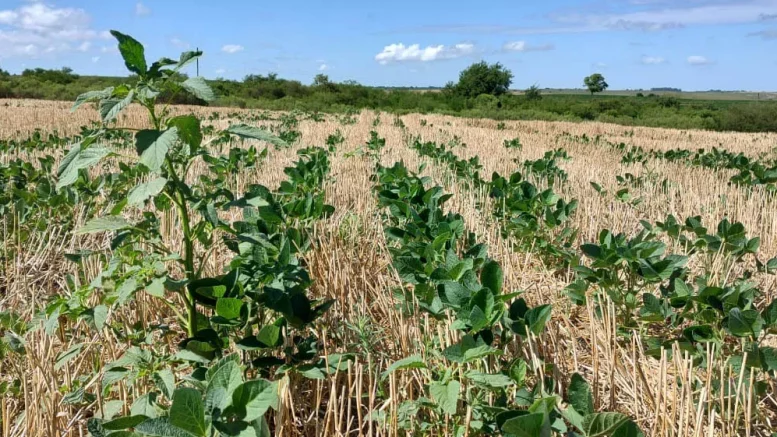“Green manure plays a significant role in suppressing several weeds…”
Patricia Andrea Monquero is a professor at the Federal University of São Carlos, former president of the Brazilian Society of Weed Science and winner of the first edition of the science and research category at the Women of Agribusiness Congress. Monquero has a degree in agronomy, a M.Sc. and a Ph.D. in phytotechnics from USP.

Patricia Monquero, professor at UFSCar
AgriBrasilis – Can GMO plants (herbicide resistant) be harmful to weed management?
Patricia Monquero – GMO plants should be seen as a support tool in the management of weeds in the conventional agricultural system. When RR [roundup-ready] soybean arrived on the Brazilian market, for example, it was crucial for controlling weeds such as Bidens pilosa, Euphorbia heterophylla and Urochloa plantaginea, which already had herbicide-resistant biotypes since the beginning of the 90s, before the introduction of GMO plants in Brazil. At the time, this resulted in a significant increase in production costs, especially in soybeans.
The big problem is how farmers use this technology. If a farmer does not practice crop rotation and the rotation of herbicide tolerance traits, they tend to always use the same herbicide, whether in soybeans, corn or cotton, which certainly accelerates the emergence of resistance within their area. This is exactly what happened with glyphosate: after the release of GMO crops tolerant to glyphosate, we soon had the first case of weeds with resistant biotypes.
“…by continually applying the same herbicide, or herbicides with the same mechanism of action, we select resistant individuals over time, eliminating susceptible ones from the area and allowing resistant ones to predominate”
AgriBrasilis – Why do weeds become resistant and what are the different resistance mechanisms?
Patricia Monquero – Weeds have a vast genetic variability, since we do not manipulate their genes as we do with crops. Therefore, within a population of weeds, there will be individuals with characteristics that confer resistance to certain products, but at a very low frequency. What happens is that, by continually applying the same herbicide, or herbicides with the same mechanism of action, we select resistant individuals over time, eliminating susceptible ones from the area and allowing resistant ones to predominate.
There are several resistance mechanisms. For example, absorption can be impeded by barriers that make it difficult for the product to enter the plant. The differential translocation of herbicides can lead to the accumulation of the products in vacuoles, where they do not perform their function, or the rapid death of some parts of the plant can occur to prevent the movement of the product.
Plants can also metabolize herbicides into non-toxic components before they reach the site of action. Another mechanism is the change in the site of action of the herbicide within the plant. For example, the enzyme acetolactate synthase (ALS), the target of many herbicides, can be modified in an amino acid, meaning that the herbicide no longer recognizes it as a target and the plant is not affected. Additionally, the plant may overproduce the target enzyme, which allows the herbicide to inhibit the enzyme but the plant still has enough to continue its normal metabolism.
AgriBrasilis – What are the agricultural practices to minimize the development of resistance?
Patricia Monquero – We can incorporate many approaches, in addition to chemical products, including cultural methods, preventive methods, such as cleaning conveyors, machinery and irrigation canals, as well as adequate care during the off-season and the use of certified seeds.
Mechanical and biological methods whenever possible are also viable options. Furthermore, new technologies, such as equipment that uses laser beams or shocks (the oldest in Brazil) to kill plants can be considered. When using chemical methods, it is essential to carefully plan and consider rotation of mechanisms of action to avoid the development of resistance.
This integrated, multifaceted approach is critical to ensuring long-term success in weed management, and is known as Integrated Weed Management.
AgriBrasilis – What control methods are recommended for plants that have already developed resistance?
Patricia Monquero – It is crucial to carry out adequate management during the off-season and go beyond chemical control, considering, for example, the use of plant covers. When using herbicides, it is essential to follow some precautions:
- always apply the correct doses at the appropriate time, taking into account the phenological stage of the weed plants;
- be careful with adverse environmental conditions, such as extreme temperatures, low relative humidity and excessive wind;
- one should fully understand the equipment used to apply herbicides, performing adjustment and calibration appropriately;
- and, above all, it is necessary to alternate the herbicides’ mechanisms of action to avoid the development of resistance, and always monitor the area.
AgriBrasilis – Does mixing pesticides increase environmental impacts?
Patricia Monquero – There are three possible results for the pesticide mixture: additive, antagonistic or synergistic. In the case of the additive effect, the mixing result is the same as if the products were applied separately.
The antagonistic effect results in lower efficiency than if the products were used separately, and may be physical (lump formation or flocculation of the pesticide solution) or chemical (not visible).
The synergistic effect results in a greater effect than the sum of the products applied separately. However, it is important to be cautious with synergistic mixtures, as although they can control weeds more effectively, they can also cause adverse effects on the crop (phytotoxicity) and the environment. The ideal is to look for mixtures that have an additive effect on crops (with known effects, as they are registered products) and a synergistic effect on the target.
It is crucial to note that most studies on the effect of mixtures focus on the target and the crop, neglecting other non-target organisms present in the field, such as earthworms and bees. Therefore, it is necessary to expand this research to ensure safety and environmental sustainability in the use of pesticide mixtures.
AgriBrasilis – What is an “underdosage” of herbicides and what are its consequences?
Patricia Monquero – When using herbicides to control weeds, it is essential to follow the dose recommended in the leaflet and avoid underdosing [dosage below the recommended].
Underdosing is not recommended, as it can accelerate the selection of resistant biotypes and it does not provide effective control of weeds in general. It is important to highlight that there are specific situations in which the use of subdoses can be justified, such as in crop-livestock integration, where the aim is to delay the growth of brachiaria between corn rows, or to obtain hormetic effects in crops, such as the application of subdoses of glyphosate in some crops to stimulate growth. However, it is important to note that these are specific goals, not related to weed control.
AgriBrasilis – Why is it important to study the behavior of herbicides in the soil?
Patricia Monquero – When a pesticide is sprayed, a series of events can occur: it can hit the desired target, the growing crop, non-target organisms, volatilize or reach the soil. It is crucial for users of these products to understand the behavior of pesticides in the environment in order to minimize adverse effects. For example, if we know that a pesticide has a tendency to volatilize, it is important to use spray nozzles that produce heavier and larger droplets, and apply in appropriate weather conditions in relation to temperature, humidity and wind.
When a pesticide reaches the soil, part of it can be retained by clay and organic matter, while another part can remain free in the soil solution, being able to be absorbed by plants or interact with organisms present in the soil, whether vertebrates or invertebrates. Additionally, there is the risk of leaching, where the pesticide can contaminate groundwater, or surface runoff, where it can be carried by rainwater to nearby bodies of water. Ignoring or underestimating behavioral aspects can be detrimental to both the effectiveness of agricultural management and the environment.
AgriBrasilis – How can “green manure” suppress the occurrence of weeds?
Patricia Monquero – Green manure plays a significant role in suppressing several weeds, and for a number of reasons. Firstly, certain plants used for green manure, such as jack beans, sunn hemp, black oats, sorghum, among others, have the ability to release chemical substances, known as allelochemicals, both while they are alive and after. These substances act as natural herbicides, helping to suppress several species of weeds, as well as other organisms, such as nematodes.
Furthermore, the straw left on the soil by green manures can hinder the germination of weed species that have very small seeds or that depend on light to germinate. This occurs because the straw creates a physical and mechanical barrier, which prevents or limits the access of light to the seeds in the soil.
Finally, the presence of a greater amount of organic matter in the soil due to the decomposition of green manures can promote an increase in soil life. This may include greater activity of beneficial organisms, such as predators or parasitoids, that feed on weed seeds, contributing to their natural suppression.
READ MORE:

